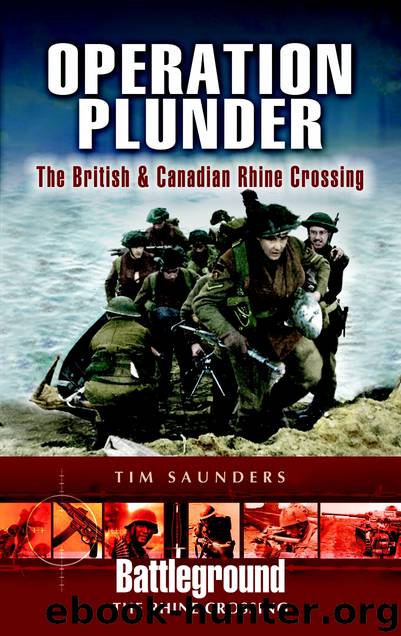Operation Plunder by Tim Saunders

Author:Tim Saunders
Language: eng
Format: epub
ISBN: 9781783460793
Publisher: Pen & Sword Books
Published: 2013-05-28T16:00:00+00:00
The line link was duly established and despite needing almost constant repair, provided a speedy method of passing information until the town was secured and the bridges built.
Counter-Attack
The most dangerous period for 1 Commando Brigade was as expected, at 1000 hours, when the copious artillery support from the home bank that the assault formations had hitherto used liberally, had to be checked for three and a half hours during the airborne operation. Unfortunately, this coincided with the likely arrival time of German operational reserves, in the form of armoured counter-attacks. In the seven hours available to them, when not patrolling, the commandos had done their best to dig-in or build sangars in the piles of rubble and had gathered as many panzerfausts as possible from prisoners and defended locations to make up for the lack of their own anti-tank weapons.
As predicted, the pressure against 1 Commando Brigade mounted, just as the artillery check fire came into force. The enemy was a Kampfgruppe of 116th Windhund Panzer Division, consisting of infantry supported by assault guns. This was one of the battle groups that had been held back to counter-attack Allied bridgeheads on the Rhine. Harried by fighter-bombers they had only been able to concentrate in the woods and copses north of Wesel, slowly and with losses to both men and armour. Hitherto, the fire of the Mountain Regiment, supplemented by that of the Army Group’s Royal Artillery, had disrupted the enemy’s assembly but now with further troops arriving the main weight of the attack fell on 45 Commando who struggled to keep the enemy at bay. Waves of grenadiers, supported by Panzer IVs and assault guns, attacked the commandos. Concentrated fire from Bren guns and other small arms fire, however, halted the German infantry assaults and, according to German sources, the attack principally failed because the Panzers were overly cautious. Presumably, deterred by the presence of Allied fighter-bombers and even medium bombers in cab ranks above the battlefield. Also, they would have been at a considerable disadvantage if they had attempted to fight amongst the rubble of the town.
Download
This site does not store any files on its server. We only index and link to content provided by other sites. Please contact the content providers to delete copyright contents if any and email us, we'll remove relevant links or contents immediately.
| Africa | Americas |
| Arctic & Antarctica | Asia |
| Australia & Oceania | Europe |
| Middle East | Russia |
| United States | World |
| Ancient Civilizations | Military |
| Historical Study & Educational Resources |
Flight by Elephant(1482)
The Rise and Fall of the Third Reich: A History of Nazi Germany by William L. Shirer(1384)
Unbroken: A World War II Story of Survival, Resilience, and Redemption by Hillenbrand Laura(1102)
German submarine U-1105 'Black Panther' by Aaron Stephan Hamilton(1018)
Last Hope Island by Lynne Olson(937)
A Bridge Too Far by Cornelius Ryan(929)
The Victors - Eisenhower and His Boys The Men of World War II by Stephen E. Ambrose(904)
War by Unknown(904)
The Guns at Last Light: The War in Western Europe, 1944-1945 by Rick Atkinson(888)
Rogue Heroes: The History of the SAS, Britain's Secret Special Forces Unit That Sabotaged the Nazis and Changed the Nature of War by Ben Macintyre(884)
0060740124.(F4) by Robert W. Walker(872)
The Hitler Options: Alternate Decisions of World War II by Kenneth Macksey(865)
The Railway Man by Eric Lomax(847)
All the Gallant Men by Donald Stratton(815)
Hitler's Vikings by Jonathan Trigg(809)
A Tragedy of Democracy by Greg Robinson(800)
Churchill's Secret War by Madhusree Mukerjee(799)
Hitler's Armies by Chris McNab(782)
We Die Alone: A WWII Epic of Escape and Endurance by David Howarth & Stephen E. Ambrose(747)
